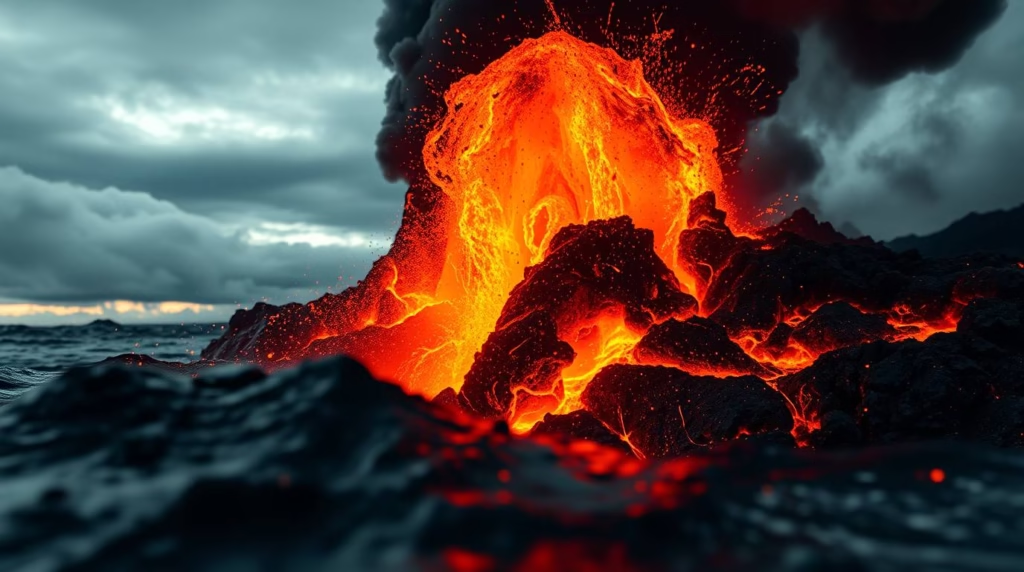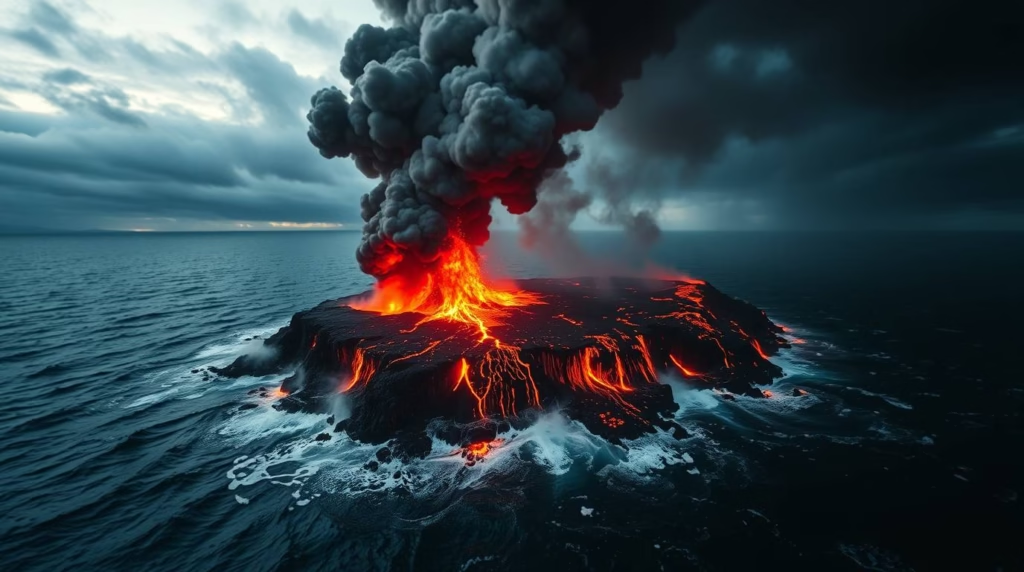A New Island Emerged from the Ocean – Leaving Scientists in Awe
On the southern coast of Iceland, a quiet miracle of nature rose from the depths of the Atlantic Ocean in 1963. The formation of Surtsey Island became one of the most astonishing geological and biological events of the 20th century. What began as a thunderous volcanic eruption beneath the sea soon turned into an extraordinary natural laboratory where scientists could observe the first steps of life on untouched land.
Today, decades later, Surtsey is far more than a volcanic island—it is a living testament to Earth’s power and nature’s resilience. Researchers from across the globe view it as a remarkable example of how ecosystems develop in isolation, free from human interference.
The Fiery Birth of Surtsey: Iceland’s Living Volcano
In November 1963, fishermen off Iceland’s southern coast witnessed something they could hardly believe—columns of steam and ash shooting up from the ocean. An underwater volcano had erupted, giving birth to a brand-new island that would later be named Surtsey, after Surtr, the fire giant of Norse mythology.
This event was rare even by geological standards. As geographer Olga Kolbrún Vilmundardóttir of Iceland’s Natural Science Institute explained, “It is very rare to have an eruption where an island forms and is long-lasting. In this region, it occurs once every 3,000 to 5,000 years.”
Many similar eruptions create temporary landforms that are quickly reclaimed by the sea. But Surtsey defied those odds. Within weeks, magma and ash built a stable landmass that eventually reached a height of nearly 170 meters above sea level. Its surface cooled and hardened, forming rugged cliffs and black lava fields—an environment as raw as the day Earth first formed.
By the time the eruption ended in 1967, Surtsey covered about 1.4 square kilometers. What set it apart was not only its sudden creation but also the strict protection that followed. The Icelandic government declared it a natural reserve, banning human interference. This decision ensured that the island would remain untouched—a pristine stage for nature’s grand experiment.
The First Signs of Life on a Dead Island
In 1964, explorers and scientists carefully set foot on Surtsey for the first official research expedition. The landscape was harsh and uninviting—hot rocks, ash, and volcanic sands stretched in every direction. Yet, even in this lifeless environment, signs of vitality were already emerging.
Researchers noticed seeds, bits of driftwood, and plant residues washed ashore by waves. Migrating birds circled overhead, seemingly drawn to the strange new island. During one visit, scientists discovered the first plant struggling to grow through volcanic soil—a remarkable event, given that Surtsey was less than a year old.
The initial assumption was that colonization would follow a predictable ecological order: algae and mosses would appear first, followed by lichens, grasses, and eventually shrubs. Surprisingly, the process did not follow textbook patterns. Instead, plants began to appear sporadically, carried by ocean currents and birds, skipping some of the expected early stages of soil formation.
Nature was clearly rewriting its own rules.
Birds: Nature’s Accidental Gardeners
Among the most fascinating developments on Surtsey was the arrival of birds, especially black-backed gulls. By the early 1980s, these gulls began nesting across the barren island. Unintentionally, they became its first ecosystem engineers.
Their nesting habits introduced new materials—feathers, droppings, uneaten fish, and plant debris. Over time, their guano (nutrient-rich bird droppings) transformed patches of ash into fertile soil, providing the nutrients that enabled hardy plants to thrive.
Dr. Pawel Wasowicz, director of botany at the Icelandic Natural Science Institute, described the discovery as groundbreaking. “From Darwin’s time, biologists thought that only plants with meaty fruits could accompany birds on flight. But on Surtsey, most plant species lacked fleshy fruits. Nearly all of them arrived through the faeces of seabirds.”
This realization redefined how ecologists understand species dispersal. The gulls didn’t just bring plants—they brought an entire ecosystem blueprint. In their wake followed grasses, mosses, and even small shrubs—all transforming the once barren island into a living, breathing landscape.
An Evolving Ecosystem: From Ash to Green
Over the next few decades, Surtsey underwent a stunning transformation. By the late 1990s, over 60 plant species had been recorded, including sea rocket, mosses, and grasses. Insects followed—beetles, spiders, and other tiny life forms that came via wind or driftwood.
Each year brought fresh surprises. The island’s nutrient cycle became more complex as birds nested, plants matured, and decomposing material enriched the soil. The emerging community was small but stable—a miniature example of ecological succession in action.
By the early 21st century, scientists observed the development of distinct microhabitats. Some areas remained dry and barren, while others bloomed with vegetation. These environmental contrasts allowed researchers to study how biodiversity evolves over time, depending on soil composition and exposure to the sea.
The lessons learned from Surtsey continue to help ecologists understand how life regenerates after volcanic eruptions, forest fires, or other natural disasters.

Seals Arrive: The Chain of Life Expands
Another dramatic milestone in Surtsey’s evolution was the arrival of grey seals. As the rocky shores stabilized, seals found them perfect for resting, breeding, and raising their pups.
Their presence added a new nutrient source to the island’s ecosystem. Seal droppings and placentas further fertilized the soil, indirectly supporting more vegetation and insect activity. Soon, coastal plants began to flourish in areas frequented by the seals, showing how marine life can support terrestrial ecosystems.
The dynamic interplay between birds, seals, and plants created a self-sustaining circle of life. Every year, researchers observed how seasonal bird migrations and marine visits subtly reshaped the island’s evolution. Even predators such as orcas, visible offshore, were part of Surtsey’s growing ecological tapestry.
Surtsey thus became more than a scientific curiosity—it evolved into a symbol of resilience and ecological cooperation.
Why Scientists Protect Surtsey So Fiercely
Unlike most remote islands, Surtsey’s access remains strictly controlled. Only a few scientists are allowed to step foot on it each year. Visitors must sterilize equipment and follow strict procedures to avoid introducing foreign species.
Research conducted here is part of one of the world’s longest-running ecological experiments. The untouched nature of Surtsey allows scientists to observe ecosystem development with unparalleled accuracy—without the contamination of human interference.
As Olga Vilmundardóttir noted, “On the mainland, human influence exists everywhere. But on Surtsey, you are truly in nature. All you hear are seabirds and the rhythm of the ocean. Sometimes orcas surface offshore or seals watch curiously from the waves. It’s a reminder of what our planet once was.”
This commitment to preservation has earned Surtsey recognition as a UNESCO World Heritage Site since 2008. The classification not only protects the island but also highlights its importance for understanding Earth’s biological resilience.
Lessons from Surtsey: Resilience, Renewal, and Hope
Surtsey’s ongoing transformation provides profound insight into how life can adapt, persist, and flourish after devastation. What began as molten rock now supports thriving communities of birds, plants, and marine mammals.
The island teaches us that nature heals itself if given time and space. Its development is a living model for environmental restoration—valuable for rewilding programs, conservation policies, and efforts to rehabilitate degraded ecosystems worldwide.
Scientists studying Surtsey emphasize that many of its ecological surprises challenge long-standing assumptions. For example:
-
Plant colonization can occur faster than predicted in nutrient-poor environments.
-
Birds play a larger role in seed dispersal than previously believed.
-
Marine and terrestrial ecosystems are more connected than traditional biology recognized.
These insights now inform global ecological models and conservation research, helping experts predict how ecosystems might respond to climate change or recover from natural disasters.
The Inevitable Transformation: A Return to the Sea
Like all islands born from volcanic eruptions, Surtsey’s existence is temporary. Waves, wind, and erosion slowly carve away its edges. Scientists estimate that within a few centuries, only the volcanic core may remain above water.
Yet, this natural erosion does not diminish its significance. On the contrary, it underscores the essence of Earth’s cyclical nature—creation, growth, decay, and renewal.
Even as Surtsey gradually diminishes, it continues to inspire. Its decades-long experiment reveals not just how life begins but also how it adapts to inevitable change. Whether covered in ash or green with moss, Surtsey captures the eternal rhythm of our planet—where destruction gives rise to life, and every end marks a new beginning.
Surtsey’s Global Legacy
Surtsey remains one of the most closely monitored and scientifically valuable islands in the world. Its data contributes to climate change research, genetic biodiversity studies, and island biogeography.
The lessons drawn from Surtsey are now applied in examining volcanic islands such as Anak Krakatau in Indonesia and volcanic reefs in the Pacific. Researchers use Surtsey as a baseline model to compare how different conditions—climate, isolation, or human impact—affect ecosystem recovery.
Tourists cannot visit Surtsey, which preserves its purity, but nearby Icelandic sites such as Heimaey and the Westman Islands offer educational exhibits that showcase Surtsey’s formation and ongoing research. Through these outreach efforts, people worldwide can appreciate how this young island contributes to ecological science and environmental awareness.
Conclusion: The Island That Redefines Life’s Resilience
Surtsey’s story—beginning with fire and ending in life—is one of nature’s greatest marvels. It challenges humanity to respect the planet’s creative power and fragile balance.
More than six decades after its birth, this island continues to write new chapters in our understanding of evolution, adaptation, and sustainability. Scientists remain captivated not only by what has already happened but by what still unfolds year after year.
In a world where human impact reaches almost everywhere, Surtsey stands as a symbol of untouched beauty—a place where Earth itself is the author, and life finds a way to flourish even in the ashes.
for more related news visit BB

